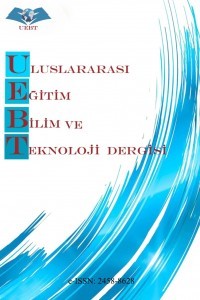ANALYZING IDEAS OF STUDENTS WHO STUDIED CHEMISTRY LABORATORY WITH RESPECT TO JIGSAW TECHNIQUE
Aim of this study is to reveal the opinion of prospective elementary science teachers who studied chemistry laboratory with respect to jigsawtechnique. Study is carried out with 23 students who are studying at elementary science education program. Study is carried out with respectto document analysis. Codes are represented in question topics. Themes could not be determined due to lack of detail on answers. It isrevealed by the study careful planning and instruction will help students in development of both cognitive and affective skills. Howeverfailure on planning and instruction may have reverse effect
Anahtar Kelimeler:
Science Education, Jigsaw, Chemistry, Student Ideas, Laboratory
KİMYA LABORATUVARI DERSİNİ BİRLEŞTİRME YÖNTEMİNE GÖRE ÇALIŞAN ÖĞRENCİLERİN GÖRÜŞLERİNİN İNCELENMESİ
Bu çalışmanın amacı kimya laboratuvarı dersini birleştirme yöntemine göre çalışan öğrencilerin görüşlerini incelemektir. Çalışma Fenbilgisi eğitimi bölümünde öğrenim görmekte olan 23 öğrenciyle yürütülmüştür. Çalışmada doküman analizi yapılmıştır. Kodlamalar sorulariçerisinde temsil edilmiştir. Temalar öğrenci cevaplarının yeterince detaylı olmamasından ötürü belirlenememiştir. Çalışma sonucundadikkatli planlama ve öğretimin öğrencilerin bilişsel ve duyuşsal özelliklerinin gelişimine yardımcı olduğu ortaya çıkarılmıştır. Ancakplanlama ve öğretimde oluşacak hatalar tam tersi sonuçlara yol açacaktır.
Keywords:
Laboratuvar, Öğrenci Görüşleri, Kimya, Birleştirme, Fen Eğitimi,
___
- Aksoy, G. ve Doymuş, K. (2011). Fen ve Teknoloji Dersi Uygulamalarında İşbirlikli Okuma-Yazma-Uygulama Tekniğinin Etkisi. GÜ, Gazi Üniversitesi Eğitim Fakültesi Dergisi, 31 (2), 381-397. Bear, G.G., Gaskins, C., Blank, J., and Chen, F.F. (2011). Delaware School Climate Survey- Student: Its factor structure, concurrent validity, and reliability. Journal of School Psychology 49, 157-174. Çetin, A., Akkus, A. Effect of Cooperative Learning Model on Students’ Academic Theoretical Knowledge. Caucasian Journal of Science, 1 (1), 1-6. Doymuş, K. (2007). Effects of a Cooperative Learning Strategy on Teaching and Learning Phases of Matter and One-Component Phase Diagrams, Chemical Education Research, 84 (11), 1857-1860. Daşdemir, İ. ve Doymuş, K. (2012a). Fen ve Teknoloji Dersinde Animasyon Kullanımının Öğrencilerin Akademik Başarılarına, Öğrenilen Bilgilerin Kalıcılığına ve Bilimsel Süreç Becerilerine Etkisi. Pegem Eğitim ve Öğretim Dergisi, 2 (3), 33-42. Evcim, H., and İpek, Ö.F. (2013). Effects of Jigsaw II on academic achievement in English prep classes. Procedia – Social and Behavioral Sciences, 70, 1651-1659. Hedeen, T. (2003). The Reverse Jigsaw: A Process Of Cooperative Learning And Discussion. Teaching Sociology, 31,325-332. Metin, M., Acisli, S., ve Kolomuc, A. (2012). Attitude of elementary prospective teachers towards science teaching. Procedia – Social and Behavioral Sciences, 46, 2004-2008. Nilsson, P., and Driel, J. (2010). Teaching together and learning together- Primary science student teacher’s and their mentors’ joint teaching and learning in the primary classroom. Teaching and Teacher Education, 26, 1309-1318. Okebukola, P.A., Owolabi, O., and Okebukola, F.O. (2013). Mother Tounge as Default Language of Instruction in Lower Primary Science Classes: Tension Between Policy Prescription and Practice in Nigeria. Journal of Research in Science Teaching, 50 (1), 62-81. Troia, G.A., Harbaugh, A.G., Shankland, R.K., Wolbers, K.A., and Lawrence, A.M. (2013). Relationships between writing motivation, writing activity, and writing performance: effects of grade, sex, and ability. Reading and Writing, 26 (1), 17 -44. Uzun, N. (2012). A sample of active learning application in science education: the thema “cell” with educational games. Procedia-Social and Behavioral Sciences, 46, 2932-2936. YÖRÜK, A. (2016). Effect of Jigsaw Method on Students Chemistry Laboratory Achievement. International Journal of Educational Sciences, 15(3), 377–381. Wang, H-Y., Stocker, J.F., and Fu, D. (2012b). New concepts of science and medicine in science and technology studies and their relevance to science education. Kaohsiung Journal of Medical Sciences, 28, 2-7.
- Başlangıç: 2015
- Yayıncı: Ahmet AKÇAY
Sayıdaki Diğer Makaleler
ANALYZING IDEAS OF STUDENTS WHO STUDIED CHEMISTRY LABORATORY WITH RESPECT TO JIGSAW TECHNIQUE
Semra DEMİR BAŞARAN, Pınar ATAKUL
PROBLEMS AND SOLUTIONS OF ACADEMICIANS IN THE FACULTY OF EDUCATION WHEN THEY DO SCIENTIFIC RESEARCH
Özgür BABAYİĞİT, Mustafa BAŞARAN
ATLETİZMDE SAAT YÖNÜ VE TERSİ KOŞMANIN, ATLETLERİN KOŞU SÜRELERİNE OLAN ETKİSİNİN İNCELENMESİ
Metin BAYRAM, A. Vahit DOĞAR, Murat KALDIRIMCI
SCIENTIFIC CREATIVITY OF PRESCHOOL TEACHER CANDIDATES
ÖĞRENCİNİN HAZIRBULUNUŞLUK SEVİYESİNİN BELİRLENMESİ: BİR MOBİL UYGULAMA ÇALIŞMASI
